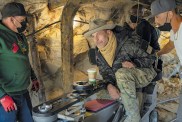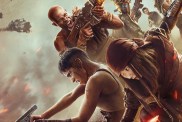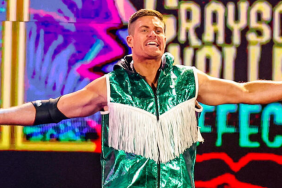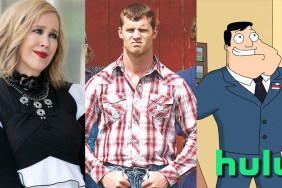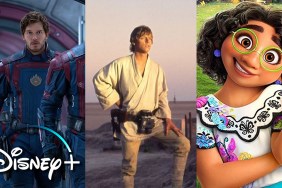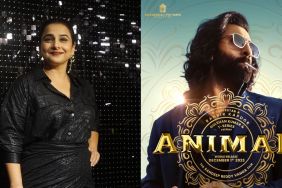Even with radical shifts in filmmaking style throughout a resume that includes Mousehunt, The Ring, The Weather Man and three “Pirates of the Caribbean” films, it’s hard to pinpoint the kind of schizoid creativity that gave birth to the weird, wonderful western world of Rango.
The story of a nameless chameleon lost in the desert (voiced by Johnny Depp) who stumbles into a Western town in crisis and reinvents himself as the town’s hero, Rango, the film pays tribute to all manner of storytelling, eclectically nodding to (among a great many other things) the works of Hunter S. Thompson, Roman Polanski, Alejandro Jodorowsky and Sergio Leone.
We’ve got a double-serving of glowing reviews (which you can check out here and here, but ComingSoon.net also had the chance to speak one on one with the man behind it all, Gore Verbinski, who shares his thoughts on the current state of animation, the decision not to film in 3D and how Rango intersects with once and future projects.
CS: Where did “Rango” begin for you?
Gore Verbinski: It started with a friend of mine, David Shannon, who is a children’s book author. We tossed out the idea of doing an animated movie together. He has a lot of books, but there was nothing I could make work. Then he, I and [producer] Jon Carls had breakfast in 2003 and he said, “What about a western with creatures of the desert?” That was basically it. That was the inception. I wrote a 12-page outline about a chameleon. Aquatic chameleons entering this town. The broad beats of this story. I wrote it and sat on it for about four years because I went off and wrote two pirate movies after that. After the third pirate film, I figured it was time to get started. I hired seven artists. Good friends that I had worked with over the years – Crash McCreery and Jim Byrkit. We just worked out of my house for 14 months. Just seven guys and a Macintosh and a lot of pencil and paper. And a microphone. That was the first year and half. We had no studio involvement. Then we brought it to Paramount and, from the beginning, was talking to Johnny about it and he was in. That was a great, to have his vote of confidence. Then we recorded the actors in 20 days and then spent another year and a half up at ILM, again with guys that I’m really close to.
CS: How quickly did the surreal side of the film enter into play?
Verbinski: I think pretty much from the outset. It’s really important. I think that the desert is a character in the film and deserts are wonderfully quiet and isolated. This is a movie about a guy searching internally for who he is. The desert speaks back to him. So that was there from the beginning.
CS: Of course you worked with Johnny Depp before, but this reminded me both of a Terry Gilliam film, whom Depp is quite connected to and also of Jim Jarmusch’s “Dead Man,” with Rango having a lot of similarities to William Blake.
Verbinski: That’s a brilliant film. I love that movie. But ours is such a bouillabaisse. We have a character who thinks of himself as a hero in the classic sense of Greek and Shakespeare and Leone and Peckinpah. I think he’s watched too many westerns himself. There’s a lot of referential stuff in there because the film is sort of about the protagonist and there’s a referential Mexican Greek chorus and talking about a hero’s ultimate demise and legend. It lends itself to a commentary on a film within a film.
CS: You cross genres to a pretty incredible extent. Was animation something that had been brewing in you for quite some time? “Mousehunt” was certainly something with a significant animated element.
Verbinski: Yeah. I’m a tremendous fan of animation, but I’ve always been sort of disappointed in it since the ’70s. With the exception of Miyazaki, I think. In the ’70s, animation had such an incredible sense of discovery and it was really doing a lot of different things. Ralph Baskhi’s work. Then it became sort of treated as though animation itself were a genre by virtue of Happy Meals and movies for kids. I think it’s a technique to tell a story. The kids that I have seen react to this movie, their reactions have been great, but we sort of made it for the kid within all of us. We never really thought of it as an animated movie. We just thought of it as a film.

CS: Can you talk about ILM and when you reached out to them?
Verbinski: Well, very early one I worked with John Knoll a tremendous amount and Hal Hickel did all the animation on Davy Jones. Tim Alexander, I had been looking forward to working with for a long time. All the guys that I hand-picked are an extension of the cast. It’s not ILM in my mind. It’s John and Hal and Steve. These are the people I know and we have a shorthand now. But the one thing that they do extraordinarily well is a photorealistic approach. That was really important in the closeups, to see what’s going on behind the eyes of the actors. To see the nuance of the performance. Not that we were in pursuit of anything photo-real, but we were looking for something emotionally real. I think that requires a tremendous amount of detail. So it was a good fit from the beginning. It’s just hard work. Every frame is manufactured and every moment is a discussion.
CS: You also shot the film in a very interesting way, filming the actors actually performing the scenes as themselves.
Verbinski: That was really all about trying to create a lively soundtrack. Trying to get actors off the page. Why abandon techniques we use in live-action? I don’t know another way to make a movie, without actors. I’d like to see them reacting, not reading.
CS: Did you cut that together as the whole film?
Verbinski: No, that was never really its intent. The video we shot was really for lip-sync reference and, occasionally, we might have a point of discussion. The film was traditionally key-frame animated. You’ll see the boom is in every shot. It was really about getting a raw performance in the audio track. So yeah, there are some fun outtakes. We tried to keep it very chaotic and feeling real on-set. Then, on a Macintosh, we’d look at the story reel and draw out on the floor in tape things like, maybe, this a room and we’d have a door or a piece of plywood on some sawhorses for a table. A couple of chairs. People had very minimal props and costumes and there’s no hair and makeup, so we’re doing like ten pages a day. On a traditional movie, you’d maybe get two. But I didn’t want actors reading so they were a little soft at first. Because on a regular movie, you may do one line of dialogue and then go sit in your trailer for 40 minutes to come back and do another single line of dialogue. This was kind of horrifying, to have to memorize ten pages every day, but also liberating. I think, eventually, people started to say, “Oh yeah! Remember acting? Remember playing a scene and acting it out?” So it was really great. We tried to keep it really fast.
:CS: It’s sort of become a catch-all that animated films come out in 3D. Can you talk about why this one isn’t and your own feelings about the format?
Verbinski: Well, I just didn’t want it to be converted. To do it right would have been an option, but I didn’t plan it that way from the onset because, when I look at it, I don’t feel like there’s a dimension missing. I don’t feel like it would enhance the story in any way. The energy is already at a premium and we’re putting it all into finishing the movie as it is. Just because there’s some kind of economical algorithm that says you can charge more at the box office to double our workload and make it 3D just seemed like nobody wanted to spend what it would cost to do it right. So I was happy to say that we weren’t going to convert. We weren’t going to turn it into garbage just so you can charge more.
CS: It’s funny you say that because, at the screening I attended, the theater accidentally handed out 3D glasses and they had to make an announcement that it was a mistake and they would be collecting them. As soon as they said that, the audience burst into applause.
Verbinski: That’s hilarious! That’s the first I’ve heard of that. That’s brilliant. Generally we get that response, though, when it’s not in 3D. I know that my own kids are like, “Thank God!” So I really just don’t feel like we’re missing any dimension.

CS: Can you talk about what’s coming up next for you?
Verbinski: I don’t know, honestly. I have quite a few options. If you ask me that question in three weeks, I can probably answer it, but there’s too many things that are conflicting schedules and I still have to factor availabilities and everything else. So whatever I tell you will be wrong in two days. But I definitely want to do a live-action picture again, but I’d also love to develop an animated film again, too. Obviously, that takes about a year and half for the process before even going for the big spend. Making sure we have a worthy tale. We’re kicking around some ideas, but nothing that’s good enough yet. Then there’s a few live-action scripts that I’m enjoying.
CS: What about “Lone Ranger”? Is that still happening?
Verbinski: Yeah, it’s getting there. That wouldn’t shoot until next year, probably. Johnny is doing “Dark Shadows” and he’s going to play Tonto. But that’s coming along really great. It’s sort of “Don Quixote” told from Sancho Panza’s point of view.
CS: After the first “Pirates,” you did “The Weather Man,” which might be my favorite of yours…
Verbinski: Oh, thank you so much. I’m very fond of that one.
CS: Do you feel that it’s important, after making a big studio film to step aside and work on something more personal?
Verbinksi: Yeah. Well, let’s put it this way: I’m not doing a fourth “Pirates” because it doesn’t scare me anymore. And that used to be horrifying. You look at these things and here’s an animated movie. I’ve never done that. It’s sort of a paid education and it grows with you. But it stops when things get too comfortable and people phone things in. Mediocrity is a force and, for me, the way to combat it is to get nervous and get out of my element. It gets you up in the morning. It gets you excited. I’d like to try and take the amplitude down again and go tell a story where there’s no bank heist and car chase. An emotional, nuanced performance of a character. Those are always really tricky. “The Weather Man” was certainly fragile in that way.
CS: I suppose in a complete 180 of that question, is “BioShock” still on the table for you?
Verbinksi: I couldn’t really get past anybody that would spend the money that it would take to do it and keep an R rating. Alternately, I wasn’t really interested in pursuing a PG-13 version. Because the R rating is inherent. Little Sisters and injections and the whole thing. I just wanted to really, really make it a movie where, four days later, you’re still shivering and going, “Jesus Christ!”… It’s a movie that has to be really, really scary, but you also have to create a whole underwater world, so the pricetag is high. We just didn’t have any takers on an R-rated movie with that pricetag. That would be a great movie to do in 3D, though. I’d like to go into that world wearing a pair of glasses. I think in general, gaming is perfect for 3D. Anything where you’re the protagonist. The kid in “The Shining” on the big wheel, going around corridors. That’s what 3D is perfect for. To make people feel on-edge.
CS: I certainly don’t want to spoil the moment, but there’s a cameo at the end of “Rango” that’s not the actor that, at first, I thought it was. Can you comment on how that whole character and casting came about?
Verbinski: It came out of the storyboard phase. It felt like it was important for Rango to encounter his version of an iconic Western hero. If he came upon the Spirit of the West, how would that take form? The Man With No Name is clearly always going to be a parody and Timothy [Olyphant] has such a great quality to his voice. It seemed right for Rango to have that encounter. And we’re big fans of the absurd.
Rango hits theaters this Friday, March 4th.
